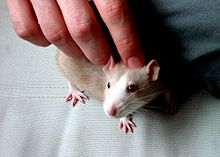Stroke
Stroking is a form of non-verbal communication . It is a gentle touch of the body that is supposed to express affection and is perceived through the touch of the skin. Stroking affects the social-emotional area of interpersonal communication, but also takes place between humans and animals.
Depending on the culture, there are different social norms about the importance and acceptance of petting, especially in public .
Forms of expression
Stroking is essential for a child's trust-building development and an essential part of a successful bond between parent and child. In the animal kingdom, it corresponds to social grooming, such as licking the fur of a young animal.
It can be an expression of affection between parents and children or between humans and animals that are tame . Occasionally people even stroke inanimate objects that are dear to them.
As a form of physical intimacy among lovers, caressing is an expression of love . Stroking the erogenous zones is called petting .
Neurophysiological effect
The importance of stroking and its influence on brain functions has been proven in animal experiments by the biologist at the University of Montreal Michael J. Meaney . The assumption that this form of touch strengthens the hippocampus and also sensitizes it to the stress indicator cortisol had been around for a long time. By stroking the child, or by grooming and licking the young animals, a certain chemical compound in the organism is uncapped (is demethylated), which remains closed without this attention. The uncapped connection now has the possibility of new chemical reactions that bring about a stabilization against stress.
Stroking in animal-assisted therapy
Long-term studies show that physical contact with pets calms the pulse and lowers blood pressure. It is believed that this relieves aggression and stress . Animal-assisted therapy makes use of this positive effect that animals have on people .
- see also: petting zoo
Stroking in the transactional analysis
In transactional analysis , caressing is generally used when a person cares for another and shows them affection. Here, however, the term is mostly meant in a figurative (not physical) sense as psychological affection ("caresses").
History
In search of the original language , Emperor Friedrich II carried out a cruel human experiment in the 13th century . On his orders, small children were only cleaned and fed by their wet nurses, but received no address or physical affection such as stroking and caressing. Due to the lack of human attention, the children died prematurely. This is documented by the Franciscan Salimbene of Parma in one of his seven chronicles.
The American psychiatrist Seymour Levine experimented with rats in 1957 by giving them 15 minutes a day through so-called “handling”: he took the young out of the nest and stroked them. In terms of effects, the adult animals showed more relaxed behavior and the production of fewer stress hormones compared to the animals that were not petted. Also, the rat-typical degradation symptoms of the brain, which are similar to human Alzheimer's disease, were not found in the patted rats.
literature
- Annegret Frank, Annie Meussen "Stroking, feeling, self-confidence: massages, perception and interaction games, relaxation stories and breathing exercises to promote body awareness" 3rd edition, Ökotopia, 2003, ISBN 3-936286-29-9
- Ilka Köhler, "Massage stories for children" 3rd edition, BVK, 2012, ISBN 978-3867402347
- Less stress from petting . In: Berliner Zeitung , September 24, 1997
Web links
- Håkan Olausson: Caress touches a nerve. Soft strokes rouse emotions. In: Nature Neuroscience . July 29, 2002, doi: 10.1038 / news020722-12 . In addition: Nerves: How the caress gets into the brain
Individual evidence
- ↑ D. Liu, J. Diorio, B. Tannenbaum, C. Caldji, D. Francis, A. Freedman, S. Sharma, D. Pearson, PM. Plotsky, MJ. Meaney: Maternal care, hippocampal glucocorticoid receptors, and hypothalamic-pituitary-adrenal responses to stress . In: Science , September 12, 1997, 277 (5332), pp. 1659-1662, PMID 9287218
- ↑ DL Champagne, RC Bagot, F. van Hasselt, G. Ramakers, MJ Meaney, ER de Kloet, M. Joëls, H. Krugers: Maternal Care and Hippocampal Plasticity: Evidence for Experience-Dependent Structural Plasticity, Altered Synaptic Functioning, and Differential Responsiveness to Glucocorticoids and Stress . In: The Journal of Neuroscience , June 4, 2008, 28 (23), pp. 6037-6045
- ↑ Ulrich T. Egle: Pain and Weeping . Congress: Lindau Psychotherapy Weeks 2008 - “Laughing” / “Weeping”. Lindau, lecture on DVD
- ↑ Dorothy E. Babcock, Terry D. Keepers: Growing Together. Transactional analysis for parents and educators . 5th edition, Gütersloher Verlagshaus, 1998, ISBN 3-579-02251-2
- ↑ Eric Berne: Games of the Adults . rororo non-fiction book, 2002, ISBN 3-499-61350-6 , volume 61350
- ↑ The Chronicle of the Salimbene of Parma , edited from the edition of the MGH by Alfred Doren, 2 vols. (Historian of the German prehistory 93). Leipzig 1914.
- ↑ cited for example in: RM Sapolsky: The importance of a well-groomed child. In: Science . 1997 Sep 12; 277. PMID 9312858 ; also sciencemag.org
